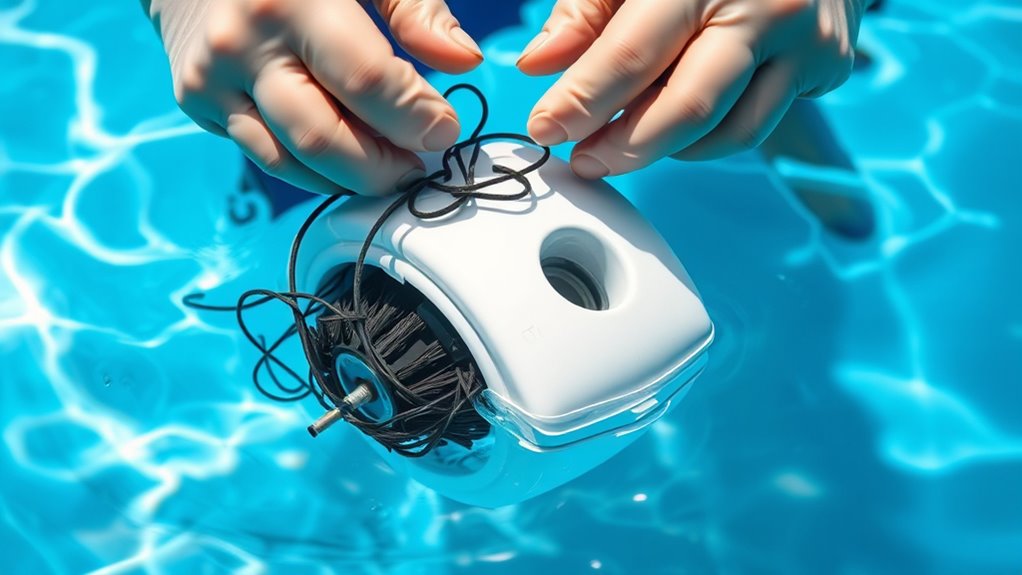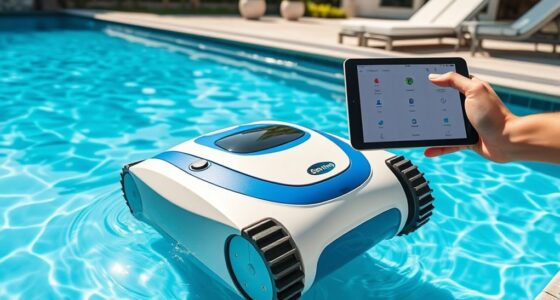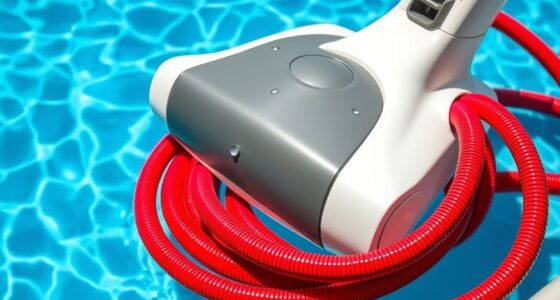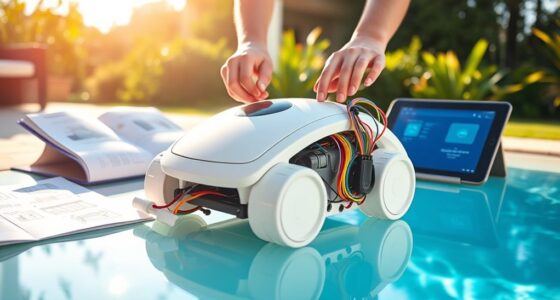To troubleshoot your suction pool cleaner, first check and clean the skimmer basket and pump strainer to guarantee proper water flow. Inspect hoses for leaks, blockages, or kinks, and make certain all connections are secure. Confirm the cleaner is placed correctly, away from obstacles, with hoses fully extended. Examine brushes and wheels for wear, and adjust system pressure if needed. If you keep these steps in mind, you’ll find it easier to get your cleaner working efficiently.
Key Takeaways
- Check and clean the skimmer basket, pump strainer, and hoses for debris or blockages to ensure proper water flow.
- Inspect hoses, fittings, and wheels for cracks, kinks, or damage; replace or repair as needed.
- Ensure the cleaner is properly positioned, fully extended, and free of tangles to optimize movement and coverage.
- Verify all connections are secure, and remove debris from filters and skimmer baskets regularly.
- Adjust pump flow rate or suction settings if the cleaner isn’t moving efficiently or missing areas.
Checking and Replacing the Skimmer Basket and Pump Strainer
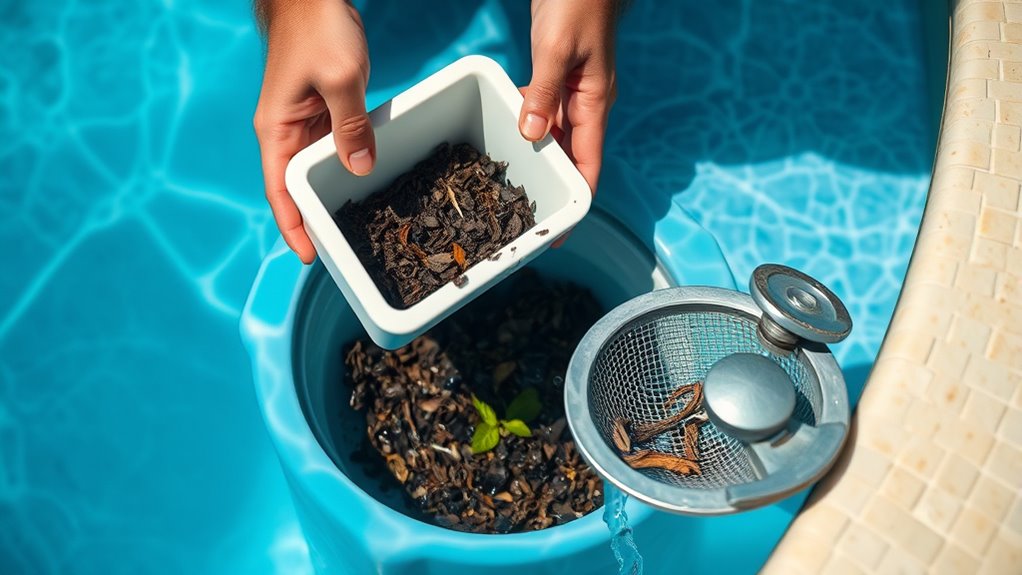
Regularly checking and replacing the skimmer basket and pump strainer is essential for your pool cleaner’s ideal performance. Start by removing the skimmer basket, which catches leaves and debris before they reach the pump. A full or clogged basket can reduce water flow, impairing your cleaner’s suction. Clean out any debris and inspect the basket for damage; replace if necessary. Next, check the pump strainer, located near the pump itself. Remove the strainer cover, clear out any debris lodged inside, and ensure the strainer is intact and properly seated. A clean, unobstructed skimmer basket and pump strainer maintain efficient water flow, preventing strain on your pool’s filtration system and ensuring your suction cleaner operates effectively. Proper maintenance and timely replacements are crucial for optimal pool operation. Additionally, regular inspections help you identify potential issues early and keep your pool in top condition. Ensuring that your pool’s water level is correctly maintained can also support optimal suction and cleaning performance, especially since water circulation plays a significant role in effective cleaning. Maintaining a cleaner’s suction power through proper care of these components can significantly extend the lifespan of your pool cleaner.
Inspecting and Clearing the Hoses and Connections
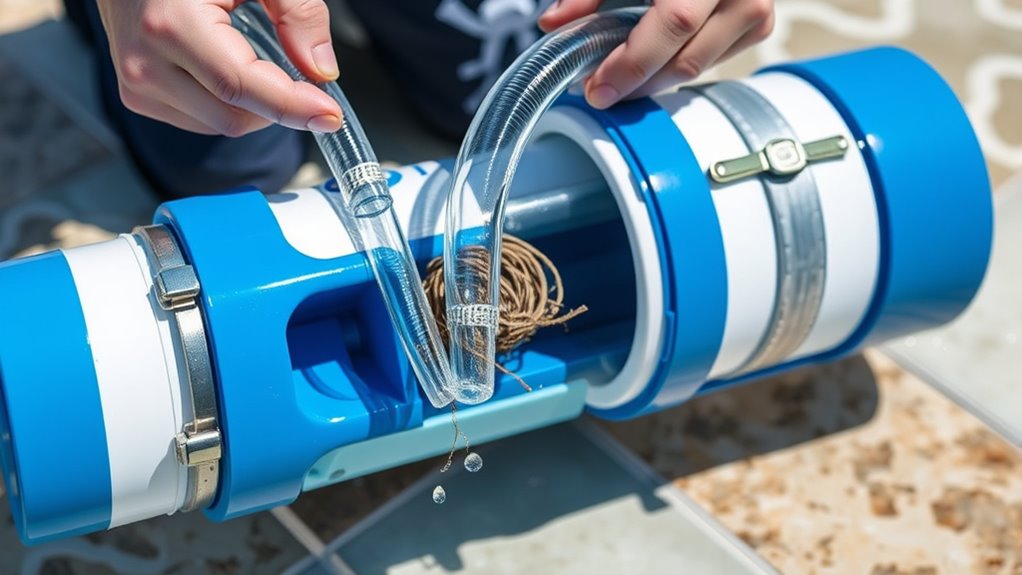
After verifying the skimmer basket and pump strainer are clean, it’s time to inspect the hoses and connections. Start with hose inspection—look for cracks, holes, or blockages that could reduce suction. Check for kinks or twists that might restrict water flow. Next, perform connection checks; ensure all hoses are securely attached to the pool cleaner and appropriate fittings. Loose or clogged connections can cause suction loss or erratic cleaning. If you find any damaged hoses, replace them promptly. Clear out any debris or obstructions inside the hoses using a hose cleaner or a long brush. Tighten loose fittings and ensure all connections are snug before restarting your pool cleaner. Proper hose inspection and connection checks are key to restoring ideal suction and cleaning efficiency. Additionally, understanding the role of contrast ratio can help you identify if your pool cleaner’s components are operating under optimal visual conditions, ensuring a thorough clean. Regularly inspecting filtration system components can also prevent buildup and maintain proper water flow. Ensuring a clean and well-maintained skimmer system can further improve overall suction and cleaning performance. Performing routine hose maintenance can extend the lifespan of your pool cleaner and improve its effectiveness.
Ensuring Proper Placement of the Pool Cleaner
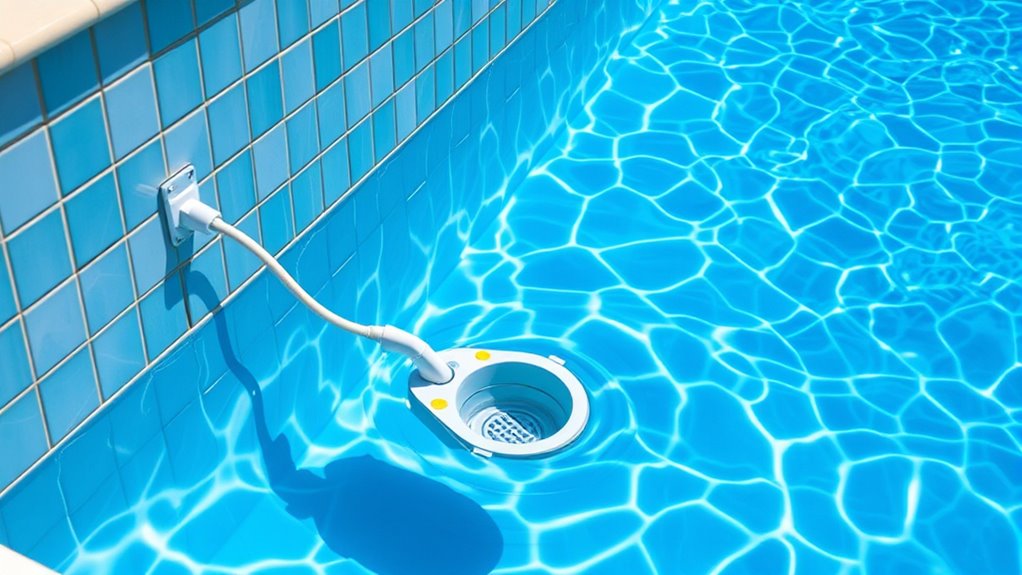
To guarantee your pool cleaner operates efficiently, you need to pay close attention to its placement within the pool. Make sure it covers all areas by positioning it away from obstacles like the pool ladder, which can interfere with its movement. Check that your pool’s chemical balance is proper, as imbalanced water can affect the cleaner’s suction and performance. Place the cleaner in an area with good water circulation, avoiding corners or tight spots that might hinder its movement. Regularly adjust its position if you notice it missing sections of the pool. Proper placement also means ensuring the hose is fully extended and free of tangles, so the cleaner can move smoothly across the entire surface. This helps maintain optimal cleaning and prevents unnecessary strain on your equipment. Additionally, understanding the suction pool cleaner mechanism can help you troubleshoot and optimize its placement for better efficiency. Ensuring proper airflow around the cleaner can further improve its suction and overall functionality. Familiarity with performance upgrades can also help you enhance your pool cleaner’s efficiency and lifespan. Being informed about water chemistry can help prevent issues that impact the cleaner’s performance and longevity. Moreover, being familiar with credit card security measures can help protect your personal information while managing your pool maintenance purchases online.
Examining the Pool Cleaner for Blockages and Debris
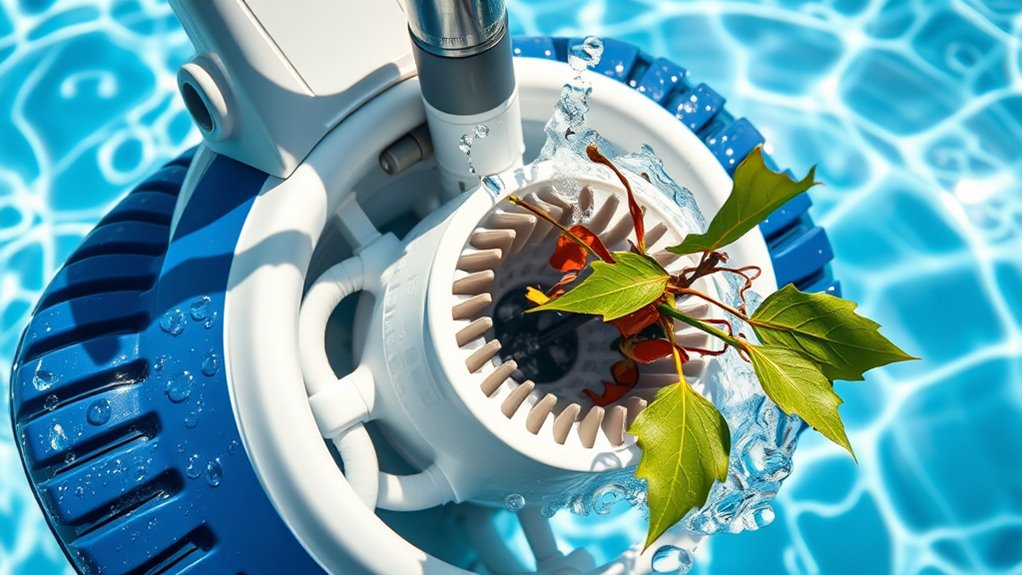
If your pool cleaner isn’t working as well as it should, start by inspecting it for blockages and debris. Check the intake and hose for leaves, dirt, or other obstructions that can hinder suction. Clear any debris you find, ensuring the filter and skimmer are clean. Additionally, examine the pool’s chemical balance; improper levels can promote algae growth, which can clog the cleaner. Use the table below to guide your inspection:
| Area to Check | What to Look For |
|---|---|
| Intake Vortex | Debris, algae buildup |
| Hose & Nozzles | Blockages, cracks |
| Filter Basket | Leaves, dirt, debris |
| Pool Water | Imbalanced chemicals |
Maintaining proper chemical balance helps prevent algae growth that could clog your cleaner, ensuring more effective operation. Proper pool maintenance also involves regular cleaning of the filter system and checking for wear and tear on moving parts. Additionally, automation technologies are increasingly used to improve pool maintenance efficiency and effectiveness. Regularly inspecting the suction system can help identify developing issues before they impact performance. Incorporating advanced filter systems can further enhance debris removal and prolong the lifespan of your cleaner.
Testing and Adjusting the Suction Power
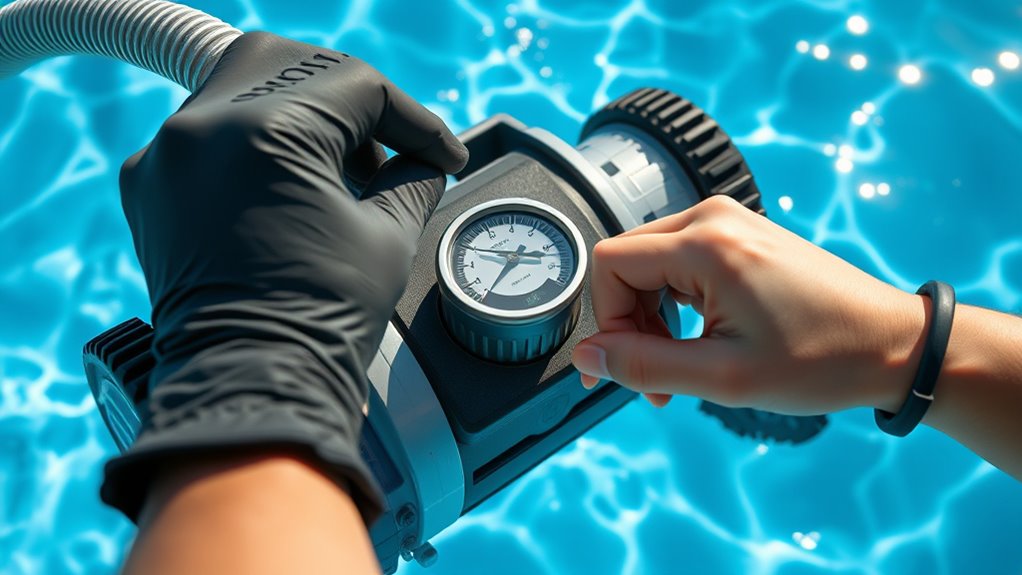
To guarantee your pool cleaner works efficiently, you need to test its suction strength. If it’s not cleaning properly, try adjusting your pool pump settings to increase or decrease the power. Small changes can make a big difference in how well your cleaner performs. Additionally, understanding how tuning software can optimize your system might help improve overall performance. Leveraging AI detection methods can also assist in diagnosing issues with your equipment’s operation, ensuring more precise adjustments. Regular maintenance of filter systems can further enhance suction efficiency and prolong the lifespan of your pool cleaner. Incorporating community engagement practices, such as seeking advice from fellow users, can provide valuable insights for troubleshooting.
Checking Suction Strength
Checking the suction strength of your pool cleaner is a crucial step in troubleshooting performance issues. If it’s too weak, the cleaner may miss spots or drift inefficiently. To assess, observe if the cleaner moves steadily and picks up debris effectively. Use a suction gauge or perform a simple test by placing the cleaner in a bucket of water to see if it holds suction. Regularly review your cleaning schedules and ensure proper chemical balancing, as these affect debris collection and suction efficiency. Here’s a quick overview:
| Issue | Possible Cause | Solution |
|---|---|---|
| Weak suction | Clogged hose or filter | Clean or replace filters |
| Inconsistent cleaning | Low water flow | Check pool skimmer and pump |
| Debris bypassing cleaner | Improper suction or placement | Adjust cleaner position |
| Excessive suction noise | Obstructions or leaks | Inspect fittings and hoses |
| Poor debris pickup | Chemical imbalance | Balance chemicals properly |
Additionally, ensure that the suction power settings are correctly adjusted to optimize cleaning performance.
Adjusting Pool Pump Settings
Adjusting your pool pump settings can considerably improve the suction power of your cleaner. Start by checking the pump’s speed and flow rate, ensuring they’re optimized for your pool size. A higher speed increases suction, but balance it to prevent excessive strain on your equipment. Proper pool chemistry, including maintaining correct pH levels and sanitizer levels, also supports algae prevention and keeps the filter and pump working efficiently. If your pool has algae issues, boosting suction can help remove debris more effectively. Regularly cleaning skimmers and filters ensures unobstructed water flow, which enhances suction power. Keep in mind that adjusting pump settings isn’t just about cleaning; it impacts overall pool health by maintaining proper circulation and preventing algae buildup. Proper pump adjustments lead to a cleaner, clearer pool.
Verifying the Pool Cleaner’s Wheels and Brushes
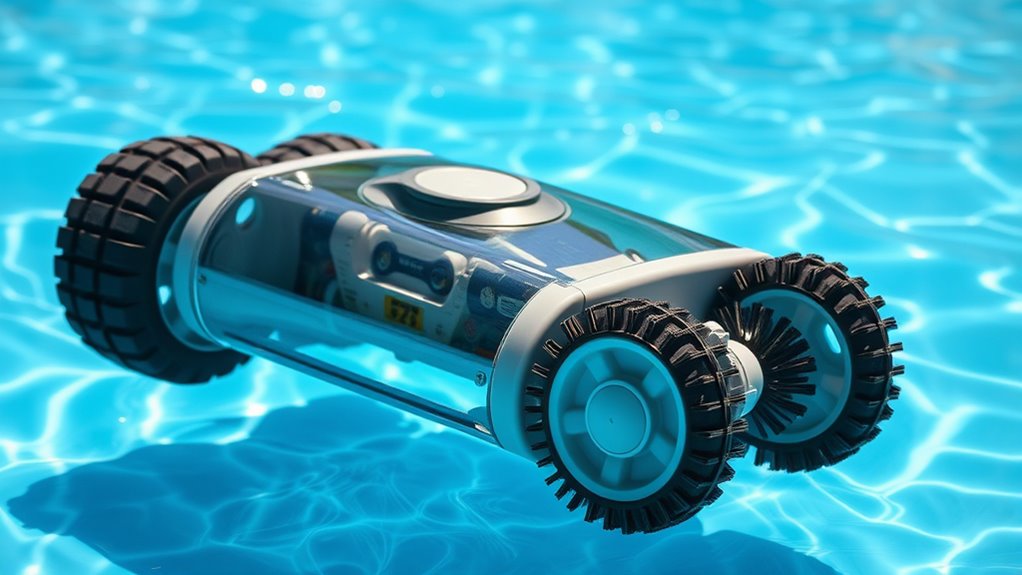
Start by inspecting the wheels to make sure they rotate smoothly without wobbling. Next, check the brushes for wear or damage that could hinder cleaning performance. Finally, verify that all parts are properly aligned to keep the cleaner moving efficiently across the pool surface.
Inspect Wheel Rotation
Have you noticed your pool cleaner isn’t moving smoothly or isn’t covering the entire pool? It’s time for a wheel inspection and rotation check. First, remove the cleaner from the pool and examine the wheels closely. Check if they spin freely without obstruction or resistance. Turn each wheel manually to see if they rotate smoothly and evenly. If a wheel doesn’t spin properly or feels stiff, debris or damage might be blocking its movement. Sometimes, a build-up of dirt or hair can hinder rotation. If you spot any damage or irregular rotation, replace or repair the wheels. Regularly inspecting wheel movement helps ensure your pool cleaner covers the entire surface efficiently, preventing missed spots and improving overall performance.
Check Brush Condition
To guarantee your pool cleaner operates effectively, it’s important to check the condition of its brushes and wheels regularly. Look for signs of brush wear or bristle damage, which can reduce cleaning efficiency. Worn brushes may appear frayed or flattened, while damaged bristles won’t scrub surfaces properly. If you notice significant wear or damage, replace the brushes promptly to keep your cleaner working smoothly. Use this quick reference:
| Issue | Symptoms | Solution |
|---|---|---|
| Brush wear | Frayed or flattened bristles | Replace brushes |
| Bristle damage | Missing or broken bristles | Replace brushes |
| Wheel issues | Wheels don’t turn smoothly | Check for debris or damage |
Regular inspection guarantees your cleaner stays in top shape.
Ensure Proper Alignment
Regularly verifying that your pool cleaner’s wheels and brushes are properly aligned helps guarantee it moves efficiently across your pool’s surfaces. Misaligned wheels or brushes can cause poor cleaning, especially if the pool’s chemical balance is off, making surfaces slick or sticky. Check that the brushes are centered and turn smoothly, and that the wheels are aligned straight without wobbling. Sunlight exposure can affect plastic parts over time, causing warping or brittleness that impacts alignment. Ensure the cleaner’s components are free of debris and properly attached. Maintaining correct alignment improves suction and prevents unnecessary wear, ultimately extending the cleaner’s lifespan. Regular inspections, combined with proper pool chemical balance and protection from harsh sunlight, keep your suction pool cleaner functioning at its best.
Assessing the Pool’s Water Level and Circulation
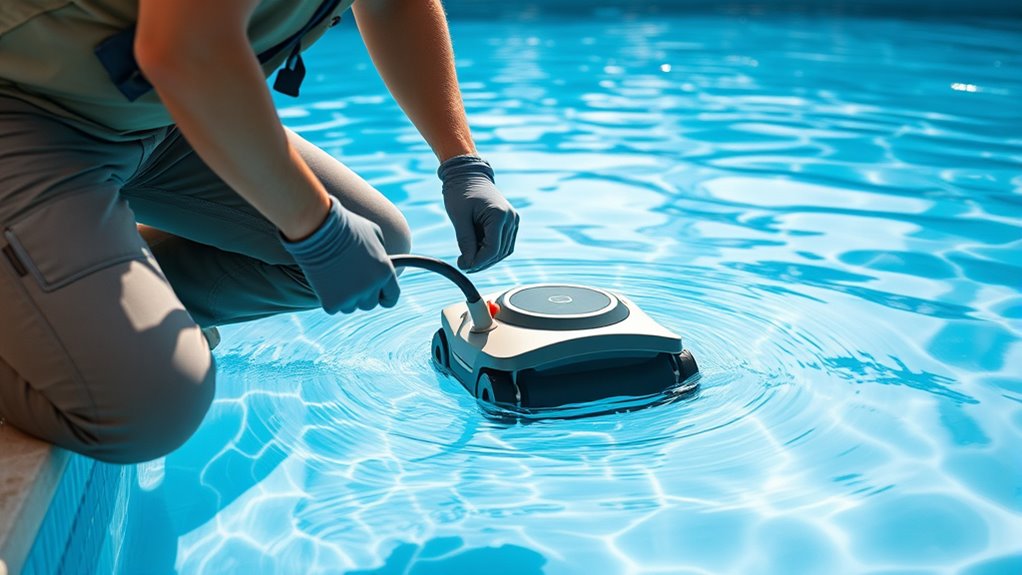
If your suction pool cleaner isn’t moving properly, start by checking the water level and circulation. Low water levels can reduce suction, while poor circulation affects debris pickup. Ensure the water is at least halfway up the skimmer opening. Also, verify pool water chemistry; imbalanced pH or chlorine levels can cause debris buildup that hampers movement. If you’re using solar heating, uneven temperature zones may create circulation issues. Use the table below to assess your system:
| Check | Solution |
|---|---|
| Water level | Add water if below skimmer opening |
| Pool water chemistry | Balance pH and chlorine levels |
| Circulation | Run pump longer or check for blockages |
| Solar heating effects | Adjust or optimize placement for even heating |
Proper water level and circulation are key to effective cleaning.
Troubleshooting Common Mechanical Issues
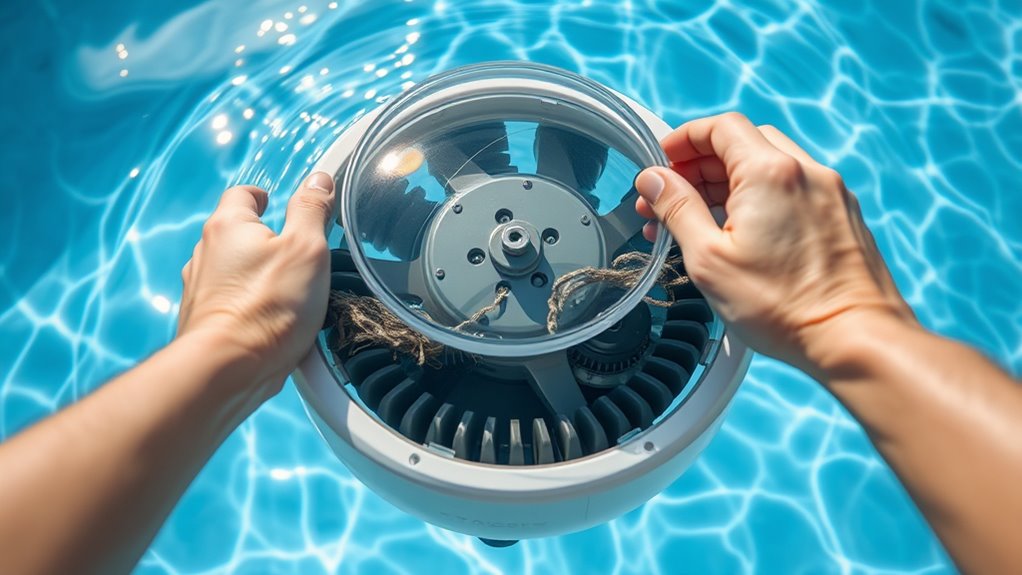
Mechanical issues are among the most common reasons a suction pool cleaner stops working effectively. If your cleaner isn’t moving properly or appears stuck, check for debris blocking the intake or hose. Ensuring your pool’s chemical balance is correct helps prevent buildup that can impair mechanical parts. Regular pool cover maintenance also reduces debris accumulation, which can strain the cleaner’s components. Inspect hoses for leaks, cracks, or clogs, and replace damaged parts promptly. Make sure the cleaner’s wheels and brushes are free of wear and tear. Properly maintaining your pool’s chemical levels and keeping the cover clean minimizes strain on the cleaner, reducing mechanical failures. Addressing these issues quickly keeps your suction pool cleaner running smoothly and extends its lifespan.
Maintaining Regular Upkeep for Optimal Performance
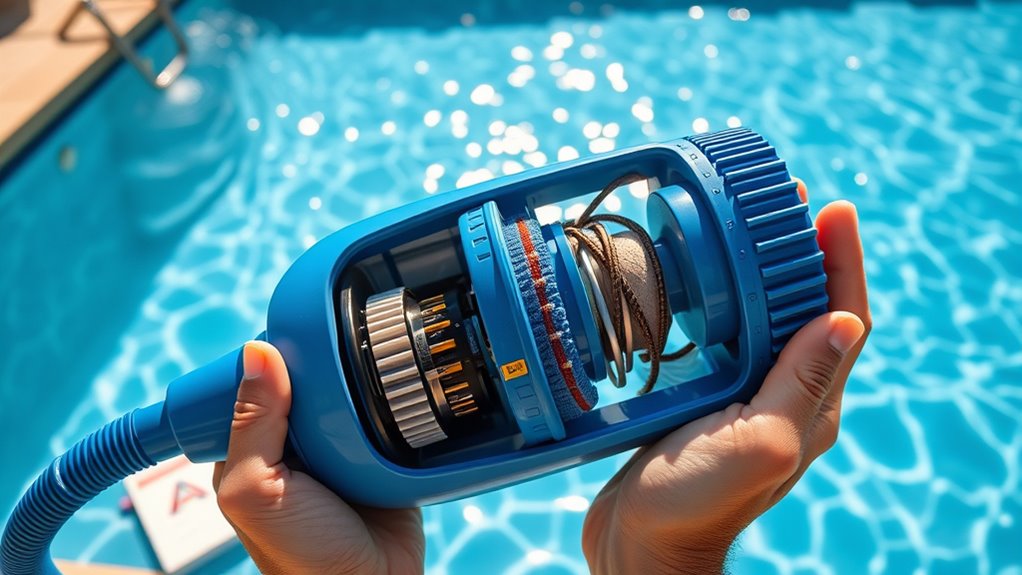
Consistent upkeep is essential to keep your suction pool cleaner performing at its best. Regular cleaning and maintenance ensure energy efficiency and proper chemical balancing, which extend the cleaner’s lifespan. Check and clean the filter regularly to prevent clogs, improving suction power. Inspect hoses for leaks or blockages and replace parts as needed. Proper chemical balancing keeps algae and debris manageable, reducing strain on the cleaner. Use the table below to guide your upkeep routine:
| Task | Frequency |
|---|---|
| Clean filter | Weekly |
| Check chemical levels | Weekly |
| Inspect hoses and connections | Monthly |
Staying on top of these tasks guarantees your cleaner runs smoothly and efficiently, saving you energy and costly repairs.
Frequently Asked Questions
How Do I Reset My Pool Cleaner’S Settings After Troubleshooting?
To reset your pool cleaner’s settings, start with the reset procedures outlined in your user manual. Usually, you’ll turn off the cleaner, then press and hold specific buttons or disconnect the power for a few minutes. Once reset, follow calibration tips to guarantee peak performance. Make sure to test the cleaner afterward, adjusting settings if needed. This helps your cleaner run smoothly and efficiently every time you use it.
Can a Faulty Pool Pump Affect the Suction Power of the Cleaner?
Think of your pool pump as the heart of your pool system. If it’s faulty or underperforming, it can weaken the suction power, much like a strained heart struggles to pump blood. A malfunctioning pump reduces water flow, making your pool cleaner less effective. Guarantee your pool pump operates smoothly to maintain ideal suction power, allowing your cleaner to do its job efficiently and keep your pool sparkling.
What Are Signs of Motor Failure in a Suction Pool Cleaner?
You’ll notice motor failure in your suction pool cleaner if it makes unusual motor noise or if you see power fluctuations. These signs indicate the motor isn’t running smoothly, which can lead to poor suction or complete failure. If the motor sounds strained or inconsistent, it’s time to check for electrical issues or worn parts. Addressing these problems early helps prevent further damage and keeps your cleaner working efficiently.
How Often Should I Replace the Pool Cleaner’S Wheels and Brushes?
You should replace your pool cleaner’s wheels and brushes every 4 to 6 months, depending on usage and wear. Regularly check for signs of deterioration, especially if your pool’s chemical balance isn’t ideal or during seasonal maintenance. Maintaining proper pool chemistry helps prolong equipment life. When you notice reduced cleaning efficiency or visible damage, it’s time for replacements to keep your cleaner performing at its best.
Is It Necessary to Calibrate the Cleaner’S Sensors Regularly?
Think of your pool cleaner’s sensors like the eyes of a lighthouse—crucial for guiding it properly. Regular sensor calibration guarantees it navigates and cleans effectively, avoiding missed spots or obstacles. While not always necessary weekly, checking and cleaning sensors periodically helps maintain peak performance. If your cleaner starts acting oddly or misses areas, it’s a good sign to perform sensor calibration and keep those cleaning sensors sharp.
Conclusion
By following these steps, you’ll keep your suction pool cleaner running smoothly, like a well-oiled machine. Regular checks and maintenance can prevent small issues from turning into big headaches. Think of it as tending a garden—you water and prune regularly to keep everything thriving. With a little attention, your cleaner will glide through your pool effortlessly, giving you sparkling water and more time to enjoy your backyard oasis.
